Photo

A woman and her dog at Jacob’s Ladder Overlook in Ohio
April 1945 photo via slidetreaurehunt at instagram
26 notes
·
View notes
Photo
OMG what a beautiful face

My doggo Disco staring off at something while I try out the camera on my new iPhone 13 Mini.
6 notes
·
View notes
Text

For some reason my dog's shadow looks like George Washington
35 notes
·
View notes
Link
"A legal struggle over pet prescription medications was ramped up in a filing in Manhattan Supreme Court."
***
A veterinary services provider accused by Chewy Inc. in an alleged scheme to divert digital sales of pet prescriptions blasted the online retailer Monday for using a New York state lawsuit to suppress competition from traditional veterinary practices.
The filing, from Maine-based Covetrus Inc. and its Weil, Gotshal & Manges attorneys, refuted Chewy’s claims that it had partnered with a New York City software firm to hijack animal medication sales to unsuspecting customers, and said that the suit had notably excluded veterinary practices that stood to lose the most from the litigation.
Chewy is based in Florida.
“The real targets of this litigation are not Covetrus but the veterinary practices that compete with Chewy for sales of prescription medications,” the filing said. “The judgment Chewy seeks would cause substantial financial harm to veterinarians and would impair their relationships with clients.”
The dispute comes amid a pitched battle in the market for pet prescriptions, as Chewy tries to capitalize on its growing dominance in the area of pet-product sales. Chewy’s launch of an online pharmacy for prescription drugs and other regulated pet products has spurred fears among brick-and-mortar veterinary practices, which have in turn contracted with companies like Covetrus to better position themselves to compete in the digital age.
Chewy’s lawsuit, filed May 19 in New York Supreme Court, Commercial Division, alleged that Vetcove Inc., an e-commerce platform that serves veterinary hospitals, had enlisted Covetrus in a “conspiracy” to intentionally interfere with Chewy’s sales of medication and regulated pet products, like diet food.
According to Chewy’s 27-page complaint, Vetcove used its proprietary software to gain access to customer data, and then “inserted” Covetrus into the scheme when it came time to confirm the prescriptions with customers’ veterinarians, as required under most state laws.
Chewy alleged that Vetcove’s software identified the contacts with customers, flooded them with misleading information and then allowed Covetrus to swoop in and redirect the sales.
The lawsuit included claims for tortious interference, unfair competition and unjust enrichment. Among other things, it seeks preliminary and permanent injunctive relief blocking the defendants from “misappropriating and using Chewy’s confidential and proprietary information without Chewy’s consent” and diverting orders.
Chewy is represented by attorneys from Manatt, Phelps & Phillips in Manhattan.
Covetrus, however, fired back Monday in a motion to dismiss that criticized Chewy for basing its lawsuit on a “fictional” theory regarding the diversion of sales. In its filing, Covetrus denied any close relationship with Vetcove, and claimed that the lawsuit was only intended to boost Chewy’s own sales.
At issue in the case, Covetrus said, was not a secretive scheme to steal prescription sales, but rather, the ability of veterinarians to consult and do business with their clients.
Covetrus instead argued that veterinarians were “essential” to the three-way relationship between pet owners, care providers and their patients. And as such, they had every right to communicate with their clients after receiving Chewy’s solicitations for prescriptions, it argued.
For example, if veterinarians determine that a requested medication is medically appropriate they may want to offer the prescriptions through their own clinics, which make up a “substantial portion” of the practice’s revenue, Covetrus said.
“Chewy’s so-called ‘customers’ in these ‘diversions’ are the clinics’ pre-existing clients, who, for good reason, may choose to purchase medications at competitive prices from the veterinarians they know and trust,” the filing said. “The glaring irony of this lawsuit is that Chewy claims to be defending ‘pet parents’ fundamental right to choose a pharmacy’ when it is Chewy that is trying to deny them that very choice.”
“If Chewy prevails,” it continued, “veterinary practices will be unable to compete effectively, and Chewy will capture even more of their revenues, potentially putting some out of business.”
The complaint, among other shortcomings, had made only “bare-bones” allegations against Covetrus, and did not establish jurisdiction over the company in New York, the attorneys argued.
As for veterinarian practices themselves, Covetrus said they were “indispensable parties” to the litigation, that should either be added to the suit or otherwise warranted dismissal of the case.
Chewy and its counsel did not immediately respond Monday to a request for comment.
The case, captioned Chewy v. Vetcove, is assigned to Justice Jennifer Schecter of the Commercial Division in Manhattan.
8 notes
·
View notes
Photo
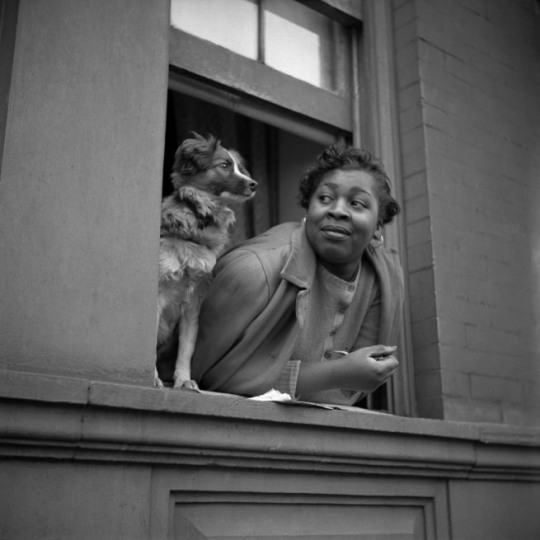
A WOMAN & HER DOG | 1943
A woman and her dog in Harlem, NY, 1943. Gordon Parks. Library of Congress
Black History Album, The Way We Were
Follow us on WEB TUMBLR PINTEREST FACEBOOK TWITTER
904 notes
·
View notes
Photo
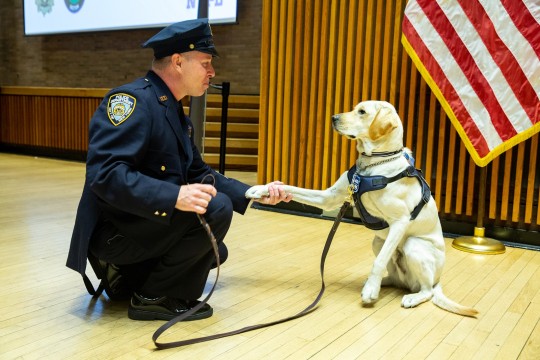
NYPD Detective Ronald Thomas plays with Piper, one of two new therapy dogs assigned to help officers dealing with mental health issues, at 1 Police Plaza on Wednesday. Joining Piper in the good work will be therapy dog Jenny.
source: NY Daily News, August 5, 2021
3 notes
·
View notes
Photo

1 note
·
View note
Link
In the thick of the COVID-19 pandemic, it seemed to Scott Neabore that the pet population had doubled as people bound to their homes sought out cats and dogs for comfort and companionship. His practice in Haddonfield, meanwhile, was still compact — just him and three vet technicians.
His schedule is fully booked with surgeries until autumn. There are no slots for more dental procedures until the beginning of next year. He has performed more spay and neuter surgeries in the last year than he ever did previously.
“The pet population essentially doubled in a year, but the veterinarian population did not,” he said. “Now we’re trying to play catch-up.”
As pet ownership sharply grew in the last year — 11.38 million households in the United States got pets during the pandemic, according to the American Pet Products Association — so did the workload for veterinary practices, many of which simultaneously grappled with COVID-19 safety protocol, concerns of thinning staff, and growing pressure to see as many patients as possible.
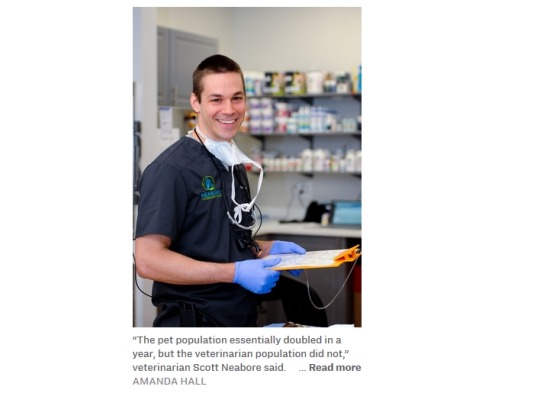
Even with nimble vet staff, there was sometimes a waiting period of six to seven hours at the Red Bank Veterinary Hospital emergency room in Hillsborough, N.J. — a delay exacerbated by some owners who brought in their pets for nonurgent matters, veterinarian Agatha Kuza said.
“My job has kind of become a general practice-emergency hybrid,” she said, noting that some people have paid the more expensive emergency hospital fee rather than wait longer to get their animal seen elsewhere.
In a typical 12-hour shift during the pandemic, Kuza saw 10 to 15 patients. On her busiest day, she recalled, she saw 30. Another day, when two other emergency clinics in the area diverted owners to nearby facilities, eight patients showed up at Red Bank Veterinary Hospital within an hour.
The work has become overwhelming, Kuza said. After already long days sometimes peppered with combative or accusatory pet owners, some employees stay an extra hour or two to finish their tasks, she said. Half of the nurses who were working at the hospital when Kuza was hired last year have resigned, and replacements are hard to find.
“I definitely already feel burned out,” said Kuza, who graduated in 2019 from the University of Pennsylvania School of Veterinary Medicine. “I don’t see myself doing emergency — or even veterinary medicine — long term.” She has begun to see a therapist, she said, and take medication.
When COVID-19 and vet medicine collided, it brewed “a perfect storm,” said Jennifer Keeler, executive director of the Pennsylvania Veterinary Medical Association.
“We started out with not being sure if vet clinics could remain open, and in the early days, they were only open for the emergency procedures,” she said. That pushed back routine wellness visits — and the backlog compounded as people began adopting or buying new pets and bringing them in for their first checkups.
“Once they were allowed to do routine care and trying to dig out of that backlog, a lot of staff members are parents whose kids are home,” she said, noting that the majority of veterinarians and veterinary technicians in the United States are women. “So a lot of vet clinics lost staff and have been unable to fill positions. It’s really put a lot of pressure on them.”
Coupled with new rules surrounding COVID-19, such as appointments that required owners to stay outside while their pet was being seen, more owners became frustrated and angry, Keeler said.
“That can be emotional for pet owners because they want to be in with their pet,” she said. “They often give a lot of push-back to vets and staff, so it’s kind of coming at vet professionals from all angles lately.”
Turnover is then high, she said, particularly when there is low pay, little job satisfaction, burnout, and compassion fatigue. Vet technicians and technologists earned an annual median pay of $36,260 in 2020, according to the Bureau of Labor Statistics. The agency found that the veterinarians averaged $108,350 a year as of last May.
“I get cursed at at least once a week,” said an emergency veterinarian in Philadelphia who requested anonymity for fear of jeopardizing her job. People also have threatened and yelled at her, she said, slammed doors in her face, and walked out on $2,000 bills. “It’s definitely gotten much worse.”
The workload, too, has been fierce: In the first week of the pandemic, she said, a few cat owners who began to spend more time at home observed their pets more closely and brought them in to be examined. She diagnosed three with having abdominal tumors. And she examined more puppies than usual, many of which came from Lancaster County, Missouri, or Ohio, hot spots for puppy mills.
“Everyone just wants a puppy so much right now that puppies that wouldn’t get adopted with heart murmurs or hernias are getting adopted,” she said.
Recently, she noticed an uptick in animals that had ingested marijuana.
She said she had used her own money to pay for the treatment of six animals surrendered to her practice during the COVID-19 outbreak. One was a puppy with a broken leg; another, a cat with a severed tail.
“There’s no end in sight,” she said, and recalled a shift when she had to handle 15 emergencies by herself. “And we’re just working harder and harder and harder.”
Despite increased stress, “in general, I’m doing better than most people,” she said. “... You have to not take things personally. You have to come up with ways to cope, or you can’t deal with it.”
As it stands, the industry feels broken, said Braelyn Bankoff, a graduate of Penn Vet. She left her job as a small-animal vet in April 2020 after the job left her anxious and unhappy.

“The vet world right now feels set up to go poorly from the start,” she said, and pointed to the high cost of vet school that led to people “feeling trapped” or “forced to work unsustainably,” and the expense of running a tight-margin animal hospital that invited the pressure of seeing as many patients a day as possible. The stress, so crippling at times, has given rise to Not One More Vet, a national nonprofit dedicated to bettering the mental health of vet staff.
“It puts more burden on the existing staff and results in crazy hours, unsustainable workloads, too many client expectations you just can’t support,” Bankoff said.
She ultimately found that the pressure was unhealthy.
“I started developing stress-related illness,” she said. “I saw a psychiatrist and had to get on antidepressants and anxiety medication.” She quit her job without another one lined up and started a job search. She landed her current position, an analyst for the National Board of Medical Examiners, in January.
“It’s absolutely amazing,” she said. “I have hobbies now. I have a life. I am no longer on any meds. I feel very much myself again, and that’s awesome.”
***
Published June 7, 2021. The author, Katie Park, is suburban development reporter for the Philadelphia Inquirer.
21 notes
·
View notes
Link
This 15-question quiz is fun & informative and gives your score upon completion. No spammy links or popups.
1 note
·
View note
Link
COVID-19 pet boom has veterinarians backlogged, burned out
May 23, 2021 - Kelli Kennedy, Associated Press
Veterinary clinics around the country, including Brooklyn, have been overrun by new four-legged patients, adding to stress among veterinarians and their staff. Vets interviewed by the Associated Press have extended hours, hired additional staff and refused to take new patients, and they still can’t keep up. Burnout and fatigue are such a concern that some practices are hiring counselors to support their weary staffs.
Approximately 12.6 million U.S. households got a new pet last year after the pandemic was declared in March 2020, according to a COVID-19 Pulse Study by the American Pet Products Association.
Meanwhile, fewer people relinquished their pets in 2020, so they needed ongoing care, experts said. And as people worked from home and spent more time with their pets, they’ve had more opportunities to notice ailments that could typically go untreated.
VERG (Veterinary Emergency and Referral Group), a 24-hour emergency and specialty animal hospital on Fourth Avenue in Gowanus, Brooklyn, reported a 40 percent jump in emergency care since the pandemic began. That’s also meant more pet hospitalizations, straining various specialties like surgery and cardiology.
“The demand continues to grow,” causing extreme weariness in a profession known for its big-hearted workers, said Verg’s chief medical officer, Dr. Brett Levitzke.
“Fear of the unknown with the pandemic leads to more intense emotions from our clients,” said Levitzke.
He’s seen expletive-laced outbursts and threats from pet owners, and also outpourings of love, with cards and baked goods. After the toll on the staff became noticeable, they hired a compassion fatigue specialist for support.
“Unfortunately, compassion fatigue, anxiety, and depression already plagued our profession, and the pandemic has certainly taken it to another level,” Levitzke said.
Vets were already struggling to meet the pre-pandemic demand, with veterinary schools unable to churn out enough doctors and techs to fill the void.
Banfield Pet Hospital, one of the largest national providers of preventive veterinary medicine, which has a location on Atlantic Avenue in Boerum Hill, had approximately half a million more pet visits in 2020 than in 2019. And its telehealth service more than doubled in volume from March through the end of last year.
During the gloomiest stretches of the pandemic, Dr. Diona Krahn’s veterinary clinic in Raleigh, North Carolina, has been a puppy fest, overrun with new four-legged patients.
Typically, she’d get three or four new puppies a week, but between shelter adoptions and private purchases, the 2020 COVID-19 pet boom brought five to seven new clients a day to her practice. Many are first-time pet owners.
Like many veterinarians across the country, she’s also been seeing more sick animals.
“Everyone is working beyond capacity at this point,” said Krahn, who added evening hours last year.
Krahn left her practice three months ago and now oversees nine veterinary and animal hospital clinics across Utah and Idaho under Pathway Vet Alliance. “All of my practices are booking out several weeks in advance.”
Thrive, another veterinary hospital primary care group, with 110 facilities across the U.S. but none in Brooklyn, reported a 20 percent increase in demand during the pandemic. Both repeated a common refrain — as humans spent more time with their pets, they were more in tune with their ailments — big and small.
“With COVID, a lot of people became powerless to the ones closest to them,” said Claire Pickens, a senior director at Thrive, “but the one thing they still had the ability to control was caring for their pet.”
Clinics have been forced to streamline, having patients fill out forms online or by phone pre-appointment because hiring additional staff often isn’t an option.
“The industry is growing at a rate that it can’t fill all the roles needed to keep up with the increased demand for services,” said Pickens.
Veterinary positions are projected to grow 16 percent by 2029, nearly four times the average of most other occupations, according to Bureau of Labor Statistics. Vet tech jobs are expected to increase nearly 20 percent in the next five years.
“We are still short staffed despite active seeking of additional staff,” said Dr. Katarzyna Ferry, Veterinary Specialty Hospital of Palm Beach Gardens.
2 notes
·
View notes
Photo

Sniffing out COVID in Thailand: Labrador retrievers fight surge
Bobby, a Labrador retriever, sits by a human sweat sample after detecting COVID-19 on Friday in Bangkok. Bobby is trained to sniff out a unique odor. [AP]
BANGKOK — Thailand has started deploying a canine virus-detecting squad in hopes of quickly identifying people with COVID-19 as the country faces a surge in cases, with clusters at construction sites, crowded slum communities and large markets.
Angel, Bobby and Bravo are among six Labrador retrievers that have been trained by researchers at the veterinary faculty of Bangkok’s Chulalongkorn University to sniff out a unique odor that people with COVID-19 produce in their sweat, the researchers say.
Since May 10, the three have tested more than 1,000 samples from college staff, students and people outside the university.
The results so far are impressive. After a few seconds of sniffing sweat samples placed in metal containers, the dogs can tell which people have COVID-19 infections. If there’s no trace of infection, the dog will walk past the sample. If it is positive, it will sit in front of it.
Prof. Kaywalee Chatdarong, head of the research team, said she was aware that other countries have been using dogs to identify coronavirus infections, including Finland, the United Arab Emirates, Germany and India, but that she had no idea if it would work in Thailand because of the country’s spicy and flavorful cuisine.
Suwanna Thanaboonsombat, a volunteer who collects samples to bring to the lab, said the canine testers add a big element of convenience because they can check samples from people who can’t go out to be tested.
“People can simply put cotton balls underneath their armpits to collect sweat samples and send them to the lab. And the result is quite accurate,” Suwanna said.
The researchers plan to send the canine team out to communities suspected of being new COVID-19 hotspots. The dogs will work inside a mobile unit, while the collecting team can comb through the community collecting samples.
According to the U.S. Centers for Disease Control and Prevention, dogs are among a small number of pets that can become infected with the coronavirus, mostly after close contact with people with COVID-19. It says the risk of animals spreading the virus to people is considered low.
The Thai researchers said that as a safety precaution, they designed the sample containers so that the dogs’ noses do not contact the samples. They also believe the receptors on cells in dogs’ respiratory tracts are not a welcoming environment for the coronavirus to attack.
Kaywalee said that while dogs can provide a fast and cheap testing alternative, they do have limitations.
She said that “5 p.m. is their dinner time. When it’s around 4:50, they will start to be distracted. So, you can’t really have them work anymore. And we can’t have them working after dinner either because they need a nap. But for me, they are heroes and heroines.”
***
This story by Tassanee Vejpongsa appeared in the New York Daily News, May 23, 2021.
2 notes
·
View notes
Photo
A boy and his dog.

Frank Buck with his dog, mining area of Hillsboro and Kingston, New Mexico
Photographer: J.C. Burge
Date: 1885 - 1892?
Negative Number: 076647
249 notes
·
View notes
Link
Perhaps some of you recall my posts in this blog from 2016, recounting my experiences with the Seresto collar and our Rottweiler Diego. The shelter where we’d adopted him recommended these collars highly. By the same token Diego had personality issues that had resulted in his going unadopted for more than a year. We were committed to Diego--he was a virtual twin to our recently deceased Stan and we were sure we could rehabilitate him. We brought him home, and indeed he made slow but steady process--until we made the mistake of getting him (and our other 2 dogs) new Seresto collars. Diego started showing abnormal behaviors almost immediately and became fearful & unresponsive. When my wife finally said, “Maybe it’s the collar” we took them off all the dogs. Within a day Diego’s behaviors started to improve--but it took months before he was back to normal. Then, sadly, we discovered lumps around his neck and he was diagnosed with the lymphoma that eventually led to his death. Online I encountered several warnings about these collars--they were even harmful to the people who handle animals.
The news article from the link above is copied in its entirety below. It appeared on March 19, 2021.
***
Congress seeks recall of popular Seresto flea collars possibly linked to hundreds of pet deaths
A congressional subcommittee has demanded the recall of a popular flea and tick collar that has been linked to the deaths of 1,700 pets and suspected to have caused illnesses in tens of thousands more.
In a letter to the manufacturer of the Seresto collar — a top seller on Amazon and at major US pet retailers — US Rep Raja Krishnamoorthi (D-Ill.) demanded an immediate recall, citing reports that it has been involved in 75,000 harmful incidents to pets and nearly 1,000 incidents involving humans, according to data from the Environmental Protection Agency.
“We believe that the actual number of deaths and injuries is much greater, since the average consumer would not know to report pet harm to EPA, an agency seemingly unrelated to consumer pet products,” Krishnamoorthi wrote in the letter.
The EPA, which regulates pet collars because they contain pesticides, also was implicated for not doing enough to address the massive number of complaints it had received, according to USA Today, which first reported the problems with the collars on March 2 along with the Midwest Center for Investigative Reporting.
The Seresto collar “is the only flea and tick collar that combines a cocktail of two pesticides,” Krishnamoorthi wrote in a letter to Jeff Simmons, chief executive of its manufacturer, Elanco Animal Health, citing EPA data. While that may make the collars more effective against fleas, “apparently, they may be more toxic to pets and humans as well,” the lawmaker added.
One incident involving a 12-year-old boy who slept in bed with a dog wearing the collar resulted in the boy being hospitalized due to seizures and vomiting, Krishnamoorthi wrote.
In addition to demanding a recall and refunds for customers from Elanco, Krishnamoorthi, chairman of the subcommittee on economic and consumer policy, is asking German pharma giant Bayer, which originally developed the collar, to release information about its toxicity.
Among the issues legislators are looking at are all communications “between Bayer and Elanco during Elanco’s acquisition of Bayer Animal Health regarding toxicity or risks of death and injury to pets or humans from Seresto flea and tick collars and the transfer of liabilities,” according to the letter.
Bayer sold its animal health division to Elanco last year for $7.5 billion. In 2019, it reported revenues of more than $300 million from the Seresto collar.
Officials at Elanco on Friday said it is cooperating with the congressional subcommittee’s inquiry and “looks forward to explaining how the media reports on this topic have been widely refuted by toxicologists and veterinarians.” The company added that “no market action, such as a recall, is warranted, nor has it been suggested from any regulatory agency.”
“There is no medical or scientific basis to initiate a recall of Seresto collars and we are disappointed this is causing confusion and unfounded fear for pet owners trying to protect their pets from fleas and ticks,” Dr. Tony Rumschlag, senior director for technical consultants at Elanco, said in a statement to USA Today.
A retired EPA employee, Karen McCormack, disagrees, as The Post reported. The collars have the most incidents of any pesticide pet products she’s ever seen, McCormick told USA Today.
Seresto is one of the most popular collars sold on Amazon, which has numerous disturbing reviews about the product.
“10 days after placing the Seresto collar on my dog, she suffered a neurological problem diagnosed as meningitis of ‘unknown origin,’” one customer wrote. “She temporarily lost the use of her hind legs and vet bills have already exceeded $5,000.”
Amazon told USA Today through a spokeswoman that it is “reviewing” the product.
***
Please: don’t use this product.
13 notes
·
View notes
Photo

Sturgis, South Dakota, August 1991: biker dog
19 notes
·
View notes
Photo
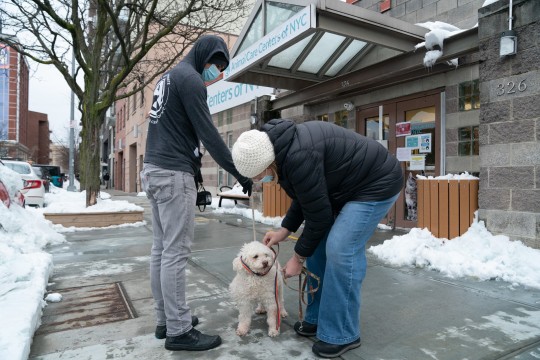
NYC to the rescue!
Quick help for COVID-hit city animal shelter
These furry friends are all good boys and girls — and bighearted New Yorkers opened their arms and homes to help save their lives Wednesday.
Animal Care Centers of NYC on E. 110th St., the only city-run animal shelter in Manhattan, shut down Wednesday after staffers tested positive for COVID-19 — forcing the entire team to quarantine and triggering a frantic hunt for short-term accommodations for the suddenly homeless and helpless dogs, cats, guinea pigs and other needy critters.
“We are facing an emergency situation,” ACC officials at the shelter near Second Ave. wrote in an email.
“Our staff responsible for walking the dogs, feeding the animals, cleaning their kennels and more are unable to come to the shelter for the next two weeks.”
“While we have staff from other departments pitching in to help, we are unable to properly care for the animals with such little human power,” the agency added in its plea for emergency fosters.
It took no time at all for New Yorkers to answer the short-term call of the wild from Creed, Bluejay, Sir Snoop, Ella Enchanted and other shelter pets.
Manhattan hospital worker Nancy Leyrer, 60, was among the first, scooping up Gizmo, a male, and Macro, a female — both Bichon poodle mixes — to take to her New Jersey home.
“These guys are older, they are seniors,” said Leyrer, who’s a foster volunteer at a rescue organization. “They are very sweet.”
“I’m doing my part and I enjoy it,” she told the Daily News while on her way back home late Wednesday. “There’s nothing better than to help a dog out and to give another person a chance to love an animal.”
Lindsey Boylan, a candidate for Manhattan borough president, described the foster effort as “critical.”
“The hope is that they are able to bring all the dogs to [other shelters] but in the event they are not, we need to be able to find homes for them in the interim,” she said. “I would stress this isn’t a permanent thing. These are fostering situations.”
The Animal Care Center email called on people willing to foster an animal to visit the shelter and take an animal in, sweetening the pot with a promise of a Lyft ride home.
“COVID cases among staff and subsequent quarantines have left us no choice but to temporarily close our Manhattan Care Center,” the agency tweeted. “We are essential workers who have never stopped working face to face with the public during this pandemic. We hope to reopen soon. Brooklyn remains open.”
Emergency services will only be given to critically ill or injured animals, the agency said.
The agency immediately began moving as many animals as it could to its Brooklyn and Staten Island centers. Animal Haven, ASPCA, Best Friends and Sean Casey Animal Rescue also pitched in.
But there was plenty of love from eager foster parents.
Adelia Honeywood, manager of grants and outreach at the Brooklyn Bridge Animal Welfare Coalition/Brooklyn Cat Cafe, said she didn’t hesitate to take in five ACC cats ranging in age from 8 to 10 years old.
“ACC does a big service to the city. Now that they’re having a health crisis with COVID, other rescue groups want to come together and step up and take these cats,” she said.

***
By Graham Rayman, Chelsia Rose Marcius, Nicholas Williams & Cathy Burke, from the New York Daily News, February 4, 2021
38 notes
·
View notes
Text
Avoiding Separation Anxiety in Your Dog
The following is useful info from Erica Salinas, in-house trainer for Second Chance Rescue NYC. Learn more about their work here: https://www.nycsecondchancerescue.org/
***
Separation anxiety is so horrible for both the dog and the pet parent, and one of the most common reasons dogs are returned, surrendered, or dumped at a shelter. Usually coupled with made-up stories about the dog. People will tell the shelter that their dog is aggressive, bit someone or the dog was found, etc., because their dog needs help, it's easier to get rid of them.
Now the dog has a label with behavior issues that aren't true and may never have a chance to be adopted again. If they are adopted, the dog will be returned, surrendered, or dumped AGAIN due to the separation anxiety.
Generally, this is not something that is just going to disappear without acknowledgment and tending to.
Avoiding separation anxiety is work but must be started now. COVID has many people working from home and having zero reasons to leave. Leaving your home daily is a must and a step to avoid separation anxiety. If your dog isn't used to you leaving, suddenly leaving when the world is back to "normal" can have a tremendous effect on your dog and lead to panic/separation anxiety.
This panic can show in the following ways:
Urinating and defecating in the home when left alone but not in your presence
Barking and howling when left alone or when separated from you
Chewing, digging, and destruction, primarily around door frames or window sills, when you are not home. This behavior can often result in self-injuries such as broken teeth, cut or scraped paws, or damaged nails.
Escaping from an area where he has been confined when left alone or separated from you. Sometimes, however, it will be fine once given the “run of the house.”
Pacing or drooling when left alone.
Increased anxiety right before you leave home.
Self-mutilation when you leave the home
Leaving your home during COVID can be a bit challenging but let's get creative. Our in-house trainer, Erica Salinas, says she takes her laptop to the car and works in it for two hours a day. She realizes that not everyone has a car, so go for a walk. Yes, it's winter, but leaving your home is so very important.
Other ways to avoid separation anxiety are the following:
Exercise
Daily routine and structure
Working for everything or nothing in life is free. Have your dog perform a command before giving a treat, food, or any attention.
Mental stimulation including food puzzles, Kongs, and other food dispensing toys
Feed them only when you leave or in another location of the home. Or give them a yummy chew or filled Kong. They should only have these items when you leave, never when you are home, so they start to associate that good things happen when you leave.
Change up your routine before leaving. Put your shoes on an hour or so before you leave. Or put your shoes on, then take them off. Put your shoes on, then walk out the door, then come back in. Please pick up your purse/bag, then put it down. Put on your coat, walk to the door then take your coat off. Etc.
Be boring when you leave. Do NOT say a word to your dog. Leave them with their yummy treat, then walk out the door. When you return, do the same thing. Do NOT talk or give them any attention for at least 10 minutes.
Discourage your dog from following you around the house. Teach them a place.
Make sure all family members walk, feed, and play with your dog to encourage bond with everyone that good things come from everyone in the family.
We all want what's best for our dogs. Keep in mind we are their world, everything, and should always do what's best for them. So please take some time to make them feel secure, so they remain happy and healthy.
***
This info comes from an email from Second Chance Rescue NYC. Please consider supporting their work. https://www.nycsecondchancerescue.org/

2 notes
·
View notes
Link
Eileen Nagle sees her family in video chats and drive-by visits, but that hasn’t made up for the lack of warm hugs in the nine months since the pandemic led her nursing home to shut its doors to visitors.
Enter Zeus.
“Zeus is a friendly little snowball, very happy,” said Nagle, 79, after the peppy bichon frise paid a visit to her room at Hebrew Home at Riverdale, overlooking the Hudson River in the Bronx. “Petting and playing with the dogs breaks up the day and gets you to forget about yourself for a while.”
Hebrew Home has had a pet therapy program for 20 years; tiny Zeus and gentle giant Marley the Great Dane are the current snugglers in residence. Now, the activities department is expanding the canine corps with two new recruits in training to give residents more of the affectionate physical contact that has become so scarce and precious in the coronavirus era.
“It’s uplifting to have Zeus come and visit me, especially with COVID and being restricted to my room,” said 80-year-old Jeff Philipson, beaming as he ran his fingers through Zeus’ silky white fur while the dog clambered on his bed. “I talk on the phone every day with my daughter and my son, but that’s as good as it can get for now.”
When the pandemic lockdown began in March, dog therapy was suspended along with most other activities at the nursing home.
“I decided we needed to re-energize the pet visiting program since there’s no outside visitation allowed,” said Daniel Reingold, founder of the pet therapy program and president and CEO of RiverSpring Health, nonprofit operator of 103-year-old Hebrew Home. “They’ve been on the floors bringing happiness and unconditional love to residents and staff alike.”

The dogs belong to staff members who bring them to work every day. But the program doesn’t allow just any dog.
“It has to be a combination of the right owner, right dog and right temperament,” said Reingold, whose own rescue dog, Kida, is one of the new recruits. “The dogs have to be assessed, follow basic commands and be able to cope with wheelchairs, elevators, medication carts and all the other things they’ll encounter on a floor.”
Cats are also used in the pet therapy program — but only robotic ones. Hebrew Home has numerous lifelike animatronic cats that purr and meow as residents hold them in their laps and stroke their fur. “The cats are especially soothing to people with dementia,” said Catherine Farrell, director of therapeutic activities, primary dog handler and owner of Marley.
“The love of an animal is incredible,” Farrell said. “It releases endorphins, reduces blood pressure, reduces anxiety. For people here who had animals in their life history, seeing dogs triggers memories and opens communication.”
While Farrell has to remain 6 feet away from residents and wear a face mask and plastic shield, Marley can plop his head on their beds as they pet him.
“To break through the social distancing barrier is really important,” Farrell said. “It’s one of the only ways they’re able to touch another living being and gain satisfaction from that physical connection.”
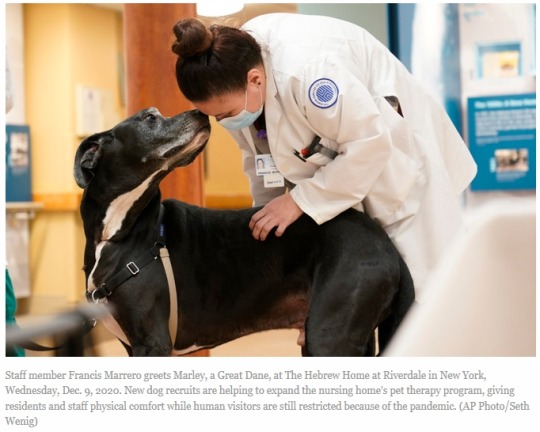
But it’s not just about petting a dog, said Olivia Cohen, dog handler and assistant director of the therapeutic activities program. For some residents, the interaction can break down barriers and open communication and emotional expression, she said.
Cohen recalls one woman who was struggling with anxiety and having trouble coping with the new environment when she moved into the home. “Nothing would get through to her to help her,” Cohen said. “But when I brought the dog to her, her complete affect changed from crying to having her face light up and telling stories about her own experiences.”
For resident Elizabeth Pagan, dog visits are a welcome respite from the isolation she has endured since she’s been restricted to FaceTime visits with her children, grandchildren and terrier-dachshund mix Ruby.
“It means a lot to me, makes me feel good when I pet the dogs,” said Pagan, who’s recovering from a stroke. “My favorite is Marley. He gives me a lot of comfort.”
22 notes
·
View notes